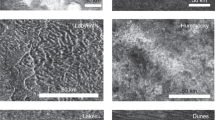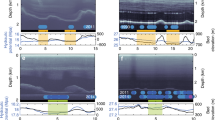Abstract
Titan has clouds, rain and lakes—like Earth—but composed of methane rather than water. Unlike Earth, most of the condensable methane (the equivalent of 5 m depth globally averaged1) lies in the atmosphere. Liquid detected on the surface (about 2 m deep) has been found by radar images only poleward of 50° latitude2,3, while dune fields pervade the tropics4. General circulation models explain this dichotomy, predicting that methane efficiently migrates to the poles from these lower latitudes5,6,7. Here we report an analysis of near-infrared spectral images8 of the region between 20° N and 20° S latitude. The data reveal that the lowest fluxes in seven wavelength bands that probe Titan's surface occur in an oval region of about 60 × 40 km2, which has been observed repeatedly since 2004. Radiative transfer analyses demonstrate that the resulting spectrum is consistent with a black surface, indicative of liquid methane on the surface. Enduring low-latitude lakes are best explained as supplied by subterranean sources (within the last 10,000 years), which may be responsible for Titan’s methane, the continual photochemical depletion of which furnishes Titan's organic chemistry9.
This is a preview of subscription content, access via your institution
Access options
Subscribe to this journal
Receive 51 print issues and online access
$199.00 per year
only $3.90 per issue
Buy this article
- Purchase on Springer Link
- Instant access to full article PDF
Prices may be subject to local taxes which are calculated during checkout



Similar content being viewed by others
References
Niemann, H. B. et al. The abundances of constituents of Titan’s atmosphere from the GCMS instrument on the Huygens probe. Nature 438, 779–784 (2005)
Stofan, E. R. et al. The lakes of Titan. Nature 445, 61–64 (2007)
Lorenz, R. D. et al. Titan’s inventory of organic surface materials. Geophys. Res. Lett. 35, L02206 (2008)
Lorenz, R. D. et al. The sand seas of Titan: Cassini RADAR observations of longitudinal dunes. Science 312, 724–727 (2006)
Rannou, P., Montmessin, F., Hourdin, F. & Lebonnois, S. The latitudinal distribution of clouds on Titan. Science 311, 201–205 (2006)
Mitchell, J. L. The drying of Titan’s dunes: Titan’s methane hydrology and its impact on atmospheric circulation. J. Geophys. Res. 113, E8015 (2008)
Schneider, T., Graves, S. D. B., Schaller, E. L. & Brown, M. E. Polar methane accumulation and rainstorms on Titan from simulations of the methane cycle. Nature 481, 58–61 (2012)
Brown, R. H. et al. The Cassini Visual and Infrared Mapping Spectrometer (VIMS) investigation. Space Sci. Rev. 115, 111–168 (2004)
Lemmon, M. T., Karkoschka, E. & Tomasko, M. Titan’s rotation—surface feature observed. Icarus 103, 329–332 (1993)
Griffith, C. A. Evidence for surface heterogeneity on Titan. Nature 364, 511–514 (1993)
Tomasko, M. G. et al. A model of Titan’s aerosols based on measurements made inside the atmosphere. Planet. Space Sci. 56, 669–707 (2008)
Tomasko, M. G., Bézard, B., Doose, L., Engel, S. & Karkoschka, E. Measurements of methane absorption by the descent imager/spectral radiometer (DISR) during its descent through Titan’s atmosphere. Planet. Space Sci. 56, 624–647 (2008)
Penteado, P. F. et al. Latitudinal variations in Titan’s methane and haze from Cassini VIMS observations. Icarus 206, 352–365 (2010)
Griffith, C. A. et al. Radiative transfer analyses of Titan’s tropical troposphere. Icarus 218, 975–988 (2012)
Brown, R. H. et al. The identification of liquid ethane in Titan’s Ontario Lacus. Nature 454, 607–610 (2008)
Grundy, W. M., Schmitt, B. & Quirico, E. The temperature-dependent spectrum of methane ice I between 0.7 and 5 µm and opportunities for near-infrared remote thermometry. Icarus 155, 486–496 (2002)
Hayes, A. G. et al. Transient surface liquid in Titan’s polar regions from Cassini. Icarus 211, 655–671 (2011)
Barnes, J. W. et al. Spectroscopy, morphometry, and photoclinometry of Titan’s dunefields from Cassini/VIMS. Icarus 195, 400–414 (2008)
Radebaugh, J. et al. Dunes on Titan observed by Cassini radar. Icarus 194, 690–703 (2008)
Griffith, C. A. et al. Characterization of clouds in Titan’s tropical atmosphere. Astrophys. J. 702, L105–L109 (2009)
Schaller, E. L., Roe, H. G., Schneider, T. & Brown, M. E. Storms in the tropics of Titan. Nature 460, 873–875 (2009)
Turtle, E. P. et al. Rapid and extensive surface changes near Titan’s equator: evidence of April showers. Science 331, 1414–1417 (2011)
Soderblom, L. A. et al. Correlations between Cassini VIMS spectra and RADAR SAR images: implications for Titan’s surface composition and the character of the Huygens Probe landing site. Planet. Space Sci. 55, 2025–2036 (2007)
Griffith, C. A. Storms, polar deposits and the methane cycle in Titan’s atmosphere. Phil. Trans R. Soc. A 367, 713–728 (2009)
Tokano, T. Impact of seas/lakes on polar meteorology of Titan: simulation by a coupled GCM-sea model. Icarus 204, 619–636 (2009)
Yung, Y. L., Allen, M. & Pinto, J. P. Photochemistry of the atmosphere of Titan—comparison between model and observations. Astrophys. J. Suppl. 55465–506 (1984)
Tobie, G., Grasset, O., Lunine, J. I., Mocquet, A. & Sotin, C. Titan’s internal structure inferred from a coupled thermal-orbital model. Icarus 175, 496–502 (2005)
de Bergh, C. et al. Applications of a new set of methane line parameters to the modeling of Titan’s spectrum in the 1.58 micron window. Planet. Space Sci. 61, 85–98 (2012)
Karkoschka, E. & Tomasko, M. G. Methane absorption coefficients for the jovian planets from laboratory, Huygens, and HST data. Icarus 205, 674–694 (2010)
Rothman, L. S. et al. The HITRAN 2008 molecular spectroscopic database. J. Quant. Spectrosc. Radiat. Transf. 110, 533–572 (2009)
Acknowledgements
Research by C.A.G., J.T., L.D., C.S. and M.G.T. are funded by NASA’s Planetary Astronomy and Cassini Data Analysis programmes. J.T. was also funded by a NASA Space Grant.
Author information
Authors and Affiliations
Contributions
C.A.G. supervised all work, and conducted the radiative tranfer analyses. J.M.L. worked on the analyses of surface albedos within the wavelength windows. R.H.B. worked on the surface identification and, as the VIMS Pricipal Investigator, all technical aspects regarding the VIMS observations. M.G.T., L.D. and C.S. collaborated on the radiative transfer analyses. J.T. conducted searches of the VIMS data base, using software written by P.F.P.
Corresponding author
Ethics declarations
Competing interests
The authors declare no competing financial interests.
Supplementary information
Supplementary Information
This file, which discusses further the geography and spectral characteristics of the dark terrains detected on Titan’s tropical surface, as well as the spectral characteristics of methane lakes and the uncertainties in the analysis, contains Supplementary Text and Data 1–4, Supplementary Tables 1–3, Supplementary Figures 1–4 and additional references. (PDF 1783 kb)
Rights and permissions
About this article
Cite this article
Griffith, C., Lora, J., Turner, J. et al. Possible tropical lakes on Titan from observations of dark terrain. Nature 486, 237–239 (2012). https://doi.org/10.1038/nature11165
Received:
Accepted:
Published:
Issue Date:
DOI: https://doi.org/10.1038/nature11165
This article is cited by
-
Science goals and new mission concepts for future exploration of Titan’s atmosphere, geology and habitability: titan POlar scout/orbitEr and in situ lake lander and DrONe explorer (POSEIDON)
Experimental Astronomy (2022)
-
A corridor of exposed ice-rich bedrock across Titan’s tropical region
Nature Astronomy (2019)
-
A post-Cassini view of Titan’s methane-based hydrologic cycle
Nature Geoscience (2018)
-
Sand dune patterns on Titan controlled by long-term climate cycles
Nature Geoscience (2015)
-
Cassini/VIMS observes rough surfaces on Titan’s Punga Mare in specular reflection
Planetary Science (2014)
Comments
By submitting a comment you agree to abide by our Terms and Community Guidelines. If you find something abusive or that does not comply with our terms or guidelines please flag it as inappropriate.



